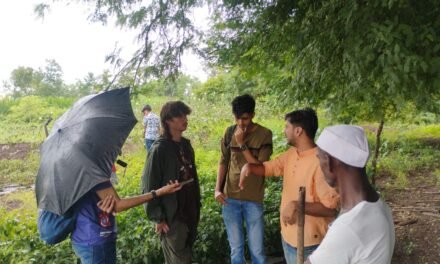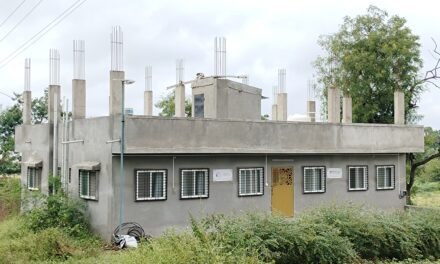I had assigned to working on the design and installation of a sprinkler irrigation system.
Introduction:-
Sprinkler irrigation is a method of applying irrigation water which is similar to natural rainfall. Water is distributed through a system of pipes usually by pumping. It is then sprayed into the air through sprinklers so that it breaks up into small water drops that fall to the ground. The pump supply system, sprinklers, and operating conditions must be designed to enable a uniform application of water.
1 When to Use Sprinkler Irrigation
1.1 Suitable crops
Sprinkler irrigation is suited for a most row, field and tree crops and water can be sprayed over or under the crop canopy. However, large sprinklers are not recommended for irrigation of delicate crops such as lettuce because the large water drops produced by the sprinklers may damage the crop.
1.2 Suitable slopes
Sprinkler irrigation is adaptable to any farmable slope, whether uniform or undulating. The lateral pipes supplying water to the sprinklers should always be laid out along the land contour whenever possible. This will minimize the pressure changes at the sprinklers and provide a uniform irrigation.
1.3 Suitable soils
Sprinklers are best suited to sandy soils with high infiltration rates although they are adaptable to most soils. The average application rate from the sprinklers (in mm/hour) is always chosen to be less than the basic infiltration rate of the soil so that surface ponding and runoff can be avoided.
Sprinklers are not suitable for soils which easily form a crust. If sprinkler irrigation is the only method available, then light fine sprays should be used. The larger sprinklers producing larger water droplets are to be avoided.
1.4 Suitable irrigation water
A good clean supply of water, free of suspended sediments, is required to avoid problems of sprinkler nozzle blockage and spoiling the crop by coating it with sediment.
2 Sprinkler System Layout
- pumping station
- main line pipe,
- lateral pipe,
- riser,
- sprinkler, and
- accessories.

Figure:-Typical Sprinkler Irrigation System Components
– The pumping station is located at the water source, and the pump lifts the water and makes it available under pressure to the system. The pump is required to overcome elevational differences between the water source and the field, counteract frictional losses within the system, and provide adequate pressure at the nozzle for good water distribution. A gravity flow system uses the potential energy in an elevational drop to create pressure for its operation.
– The mainline delivers water from the water source to the field. It may be either permanent or movable.
– The lateral pipe delivers the water from the mainline to different sections of the field. The lateral line is usually movable.
– The riser delivers the water from the lateral line to the sprinkler. The length of the riser depends on the crop, although a minimum value of 30 cm is recommended to assure a good distribution pattern.
– The sprinkler is the unit that sprays the pressurized water through an orifice and rotates to distribute water on to the field.
– The accessories are parts of the system that generally connect all of the other units together to form a watertight system. These parts are very important to an efficient system and should be installed whenever possible. Examples of accessories are tees, unions, elbows, and reducers.

Figure: sprinkler irrigation system
3 Operating Sprinkler System
3.1 Wetting patterns
3.2 Application rate
3.3 Sprinkler drop sizes
The main objective of a sprinkler system is to apply water as uniformly as possible to fill the root zone of the crop with water.
3.1 Wetting patterns
The wetting pattern from a single rotary sprinkler is not very uniform. Normally the area wetted is circular (see top view). The heaviest wetting is close to the sprinkler (see side view). For good uniformity, several sprinklers must be operated close together so that their patterns overlap For good uniformity, the overlap should be at least 65% of the wetted diameter. This determines the maximum spacing between sprinklers.

Figure:- Wetting pattern for a single sprinkler (TOP VIEW)

Figure:- Wetting patterns for several sprinklers (SIDE VIEW)
The uniformity of sprinkler applications can be affected by wind and water pressure.Spray from sprinklers is easily blown about by even a gentle breeze and this can seriously reduce uniformity. To reduce the effects of wind the sprinklers can be positioned more closely together.
Sprinklers will only work well at the right operating pressure recommended by the manufacturer. If the pressure is above or below this then the distribution will be affected. The most common problem is when the pressure is too low. This happens when pumps and pipes wear. Friction increases and so pressure at the sprinkler reduces. The result is that the water jet does not break up and all the water tends to fall in one area towards the outside of the wetted circle. If the pressure is too high then the distribution will also be poor. A fine spray develops which falls close to the sprinkler.
3.2 Application rate
This is the average rate at which water is sprayed onto the crops and is measured in mm/hour. The application rate depends on the size of sprinkler nozzles, the operating pressure and the distance between sprinklers. When selecting a sprinkler system it is important to make sure that the average application rate is less than the basic infiltration rate of the soil (see Annex 2). In this way all the water applied will be readily absorbed by the soil and there should be no runoff.
3.3 Sprinkler drop sizes
As water sprays from a sprinkler, it breaks up into small drops between 0.5 and 4.0 mm in size. The small drops fall close to the sprinkler whereas the larger ones fall close to the edge of the wetted circle. Large drops can damage delicate crops and soils and so in such conditions, it is best to use the smaller sprinklers.
Drop size is also controlled by pressure and nozzle size. When the pressure is low, drops tend to be much larger as the water jet does not break up easily. So to avoid crop and soil damage use small diameter nozzles operating at or above the normal recommended operating pressure.








